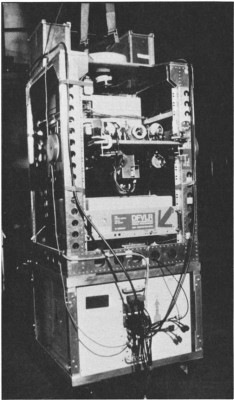Purpose of the flight and payload description
The primary objective of this flight was to measure trace gas profiles in the stratosphere and to compare the results with simultaneously performed measurements of the LIMS instrument aboard the NIMBUS 7 satellite.
For this purpose, a balloon gondola was designed and built to provide a sun pointing capability. The gondola carried three radiometers measuring the gases H2O, HNO3 and NO2 in occultation during sunset. The gondola provided two axis stabilization to better than 3 arc mins by means of a twin axis sun sensor controlling an experiment mounting plate in elevation and the complete gondola in azimuth.
Details of the balloon flight
Balloon launched on: 5/5/1979
Launch site: Columbia Scientific Balloon Facility, Palestine, Texas, US
Balloon launched by: National Scientific Balloon Facility (NSBF)
Balloon manufacturer/size/composition: Zero Pressure Balloon Winzen 150.079 m3 (12.70 microns - Stratofilm)
Flight identification number: 1136P
End of flight (L for landing time, W for last contact, otherwise termination time): 5/5/1979
Balloon flight duration (F: time at float only, otherwise total flight time in d:days / h:hours or m:minutes - ): F 3 h 20 m
Payload weight: 172 kgs
This was the second scientific flight of the instrument. The balloon ascended relatively slowly and therefore needed about 3 hours to reach floating altitude (about 37.5 km), which was a few kilometers lower than predicted. The whole measurement system worked very well until sunset and no problems were identified during the continuous check of the data stream.
After termination of the flight, the gondola descended under parachute and landed in a lake. Unfortunately, most of the electronic equipment and also optical and mechanical parts of the payload were damaged, needing extensive refurbishment to fly again. However, the repair was not performed as the same research institute was at the time developing a new instrument destined to replace the LIMS gondola. It will be denominated MIPAS (Michelson Interferometer for Passive Atmospheric Sounding) and is still in use today.
External references
- National Scientific Balloon Facility Annual Report FY 1979 National Center for Atmospheric Research, September 1980
- Stratospheric H2O and HNO3 profiles derived from solar occultation measurements J. Geophys. Res., 90(D2), 3831-3843
5666If you consider this website interesting or useful, you can help me to keep it up and running with a small donation to cover the operational costs. Just the equivalent of the price of a cup of coffee helps a lot.


